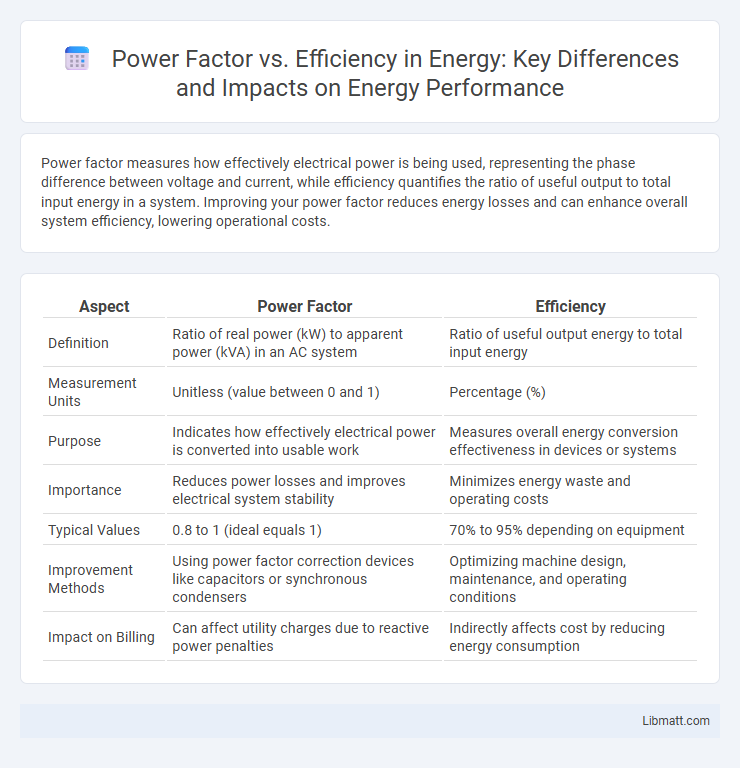Power factor measures how effectively electrical power is being used, representing the phase difference between voltage and current, while efficiency quantifies the ratio of useful output to total input energy in a system. Improving your power factor reduces energy losses and can enhance overall system efficiency, lowering operational costs.
Table of Comparison
| Aspect | Power Factor | Efficiency |
|---|---|---|
| Definition | Ratio of real power (kW) to apparent power (kVA) in an AC system | Ratio of useful output energy to total input energy |
| Measurement Units | Unitless (value between 0 and 1) | Percentage (%) |
| Purpose | Indicates how effectively electrical power is converted into usable work | Measures overall energy conversion effectiveness in devices or systems |
| Importance | Reduces power losses and improves electrical system stability | Minimizes energy waste and operating costs |
| Typical Values | 0.8 to 1 (ideal equals 1) | 70% to 95% depending on equipment |
| Improvement Methods | Using power factor correction devices like capacitors or synchronous condensers | Optimizing machine design, maintenance, and operating conditions |
| Impact on Billing | Can affect utility charges due to reactive power penalties | Indirectly affects cost by reducing energy consumption |
Understanding Power Factor: Definition and Importance
Power factor measures the efficiency of electrical power usage by comparing real power consumed to apparent power in a system, ranging from 0 to 1. A high power factor indicates that your electrical equipment is using energy effectively, reducing wasted power and minimizing energy costs. Understanding power factor is crucial for optimizing system performance and enhancing overall energy efficiency in industrial and residential settings.
Defining Efficiency in Electrical Systems
Efficiency in electrical systems measures the ratio of useful power output to total power input, indicating how effectively electrical energy is converted into desired work. Power factor, representing the phase difference between voltage and current, influences the apparent power but does not directly determine efficiency. Your system's efficiency depends on minimizing losses due to resistance, heat, and other factors rather than solely improving power factor.
The Key Differences Between Power Factor and Efficiency
Power factor measures the phase difference between voltage and current in an AC electrical system, indicating how effectively electrical power is converted into useful work, while efficiency quantifies the ratio of useful output power to total input power. Power factor is expressed as a decimal or percentage close to 1, representing the alignment of current and voltage waveforms, whereas efficiency focuses on minimizing energy losses within a device or system. Understanding the distinction highlights that power factor impacts power quality and utility billing, whereas efficiency addresses performance and energy conservation.
How Power Factor Affects System Performance
Power factor directly influences system performance by determining how effectively electrical power is converted into useful work, with a higher power factor indicating reduced energy losses and improved efficiency. Poor power factor increases reactive power, leading to higher current flow, elevated heat generation, and potential overloading of electrical components. Optimizing your power factor minimizes power wastage, lowers utility charges, and enhances the lifespan and reliability of electrical systems.
The Role of Efficiency in Energy Consumption
Efficiency directly impacts energy consumption by determining how effectively electrical power is converted into useful work, reducing wasted energy and lowering operating costs. While power factor improves the quality of power usage by minimizing reactive power, high efficiency ensures that your appliances or systems consume less electricity for the same output. Optimizing efficiency is crucial for reducing overall energy demand and enhancing sustainability in power systems.
Common Causes of Low Power Factor and Low Efficiency
Low power factor often results from inductive loads such as motors, transformers, and fluorescent lighting, which draw reactive power and reduce overall system efficiency. Low efficiency in electrical systems can stem from poor power factor, energy losses in wiring, and outdated equipment that wastes energy as heat. Improving your power factor by correcting reactive power can significantly enhance the efficiency of electrical systems, lowering energy costs and reducing strain on infrastructure.
Methods to Improve Power Factor
Improving power factor involves techniques such as installing capacitor banks to counteract inductive loads, using synchronous condensers for reactive power correction, and deploying phase advancers on induction motors. These methods reduce reactive power, minimize losses, and enhance your electrical system's overall efficiency. Regular monitoring and maintenance of power factor correction equipment ensure sustained performance and energy savings.
Strategies to Increase Electrical Efficiency
Improving electrical efficiency involves optimizing power factor by reducing reactive power through capacitor banks, synchronous condensers, or phase advancers to minimize energy losses and lower utility charges. Implementing energy-efficient devices and maintaining proper load balancing further enhance system performance, leading to reduced electrical consumption and operational costs. Monitoring power quality and utilizing automated control systems support continual adjustments, maximizing both power factor and overall electrical efficiency in industrial and commercial settings.
Real-World Impacts: Power Factor vs Efficiency in Industry
Power factor directly affects industrial energy costs by influencing the amount of reactive power drawn, which can result in higher utility charges and reduced capacity for active power delivery. Efficiency reflects how well equipment converts input energy into useful output, with lower efficiency causing increased energy consumption and operational expenses. Industries that optimize both power factor and efficiency minimize energy waste, enhance system reliability, and reduce overall operational costs.
Power Factor Correction vs Efficiency Optimization: Which Matters More?
Power factor correction improves the phase alignment between voltage and current, reducing losses in electrical systems and lowering demand charges on your utility bill. Efficiency optimization focuses on minimizing energy waste by enhancing the performance of equipment and processes, directly impacting operational costs and sustainability. While power factor correction reduces reactive power and grid strain, efficiency optimization yields greater overall energy savings, making it more critical for long-term cost reduction and environmental impact.
Power Factor vs Efficiency Infographic

 libmatt.com
libmatt.com